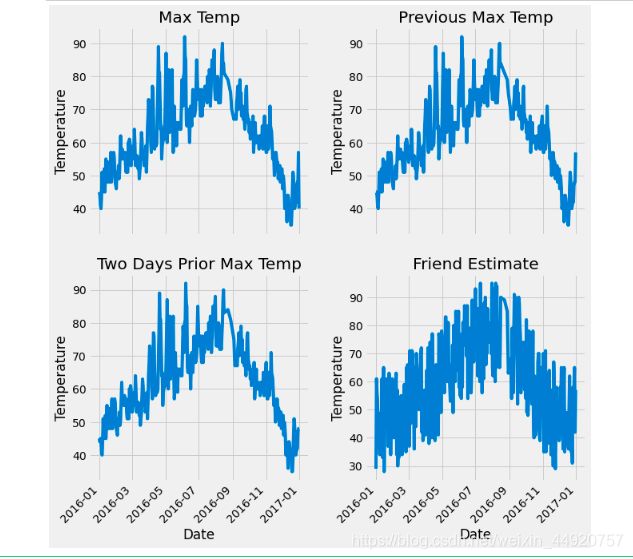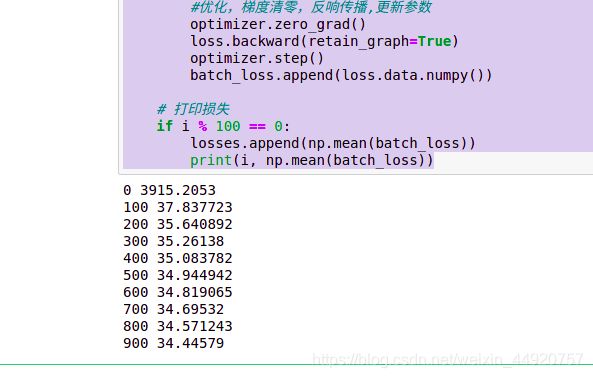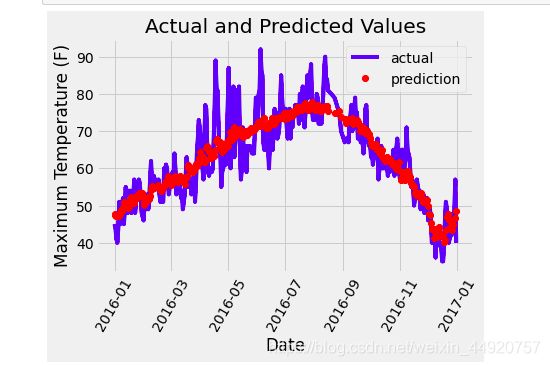搭建PyTorch神经网络进行气温预测(练习)
#torch.optim是一个实现了各种优化算法的库
import numpy as np
import pandas as pd
import matplotlib.pyplot as plt
import torch
import torch.optim as optim
#通过调用 warnings 模块中定义的 warn() 函数来发出警告
import warnings
#通过调用 filterwarnings() 将规则添加到过滤器,ignore" 忽略匹配的警告
warnings.filterwarnings("ignore")
%matplotlib inline
features = pd.read_csv('temps.csv')
#看看数据长什么样子
features.head(10)
数据表中
year,moth,day,week分别表示的具体的时间; temp_2:前天的最高温度值; temp_1:昨天的最高温度值; average:在历史中,每年这一天的平均最高温度值; actual:这就是我们的标签值了,当天的真实最高温度; friend:这一列可能是凑热闹的,你的朋友猜测的可能值,咱们不管它就好了;
print('数据维度:', features.shape)
![]()
# 处理时间数据,转换格式datetime格式方便操作
import datetime
# 分别得到年,月,日
years = features['year']
months = features['month']
days = features['day']
# datetime格式
#必须把str转换为datetime。转换方法是通过datetime.strptime()实现
#datetime.datetime.strptime:万能的日期格式转换
dates = [str(int(year)) + '-' + str(int(month)) + '-' + str(int(day)) for year, month, day in zip(years, months, days)]
dates = [datetime.datetime.strptime(date, '%Y-%m-%d') for date in dates]
dates[:5]
#展示
#准备画图
# 指定默认风格
plt.style.use('fivethirtyeight')
# 设置布局
fig, ((ax1, ax2), (ax3, ax4)) = plt.subplots(nrows=2, ncols=2, figsize = (10,10))
#X轴上旋转45度并且右对齐
fig.autofmt_xdate(rotation = 45)
# 标签值
ax1.plot(dates, features['actual'])
ax1.set_xlabel(''); ax1.set_ylabel('Temperature'); ax1.set_title('Max Temp')
# 昨天
ax2.plot(dates, features['temp_1'])
ax2.set_xlabel(''); ax2.set_ylabel('Temperature'); ax2.set_title('Previous Max Temp')
# 前天
ax3.plot(dates, features['temp_2'])
ax3.set_xlabel('Date'); ax3.set_ylabel('Temperature'); ax3.set_title('Two Days Prior Max Temp')
# 我的逗逼朋友
ax4.plot(dates, features['friend'])
ax4.set_xlabel('Date'); ax4.set_ylabel('Temperature'); ax4.set_title('Friend Estimate')
#tight_layout会自动调整子图参数,使之填充整个图像区域
plt.tight_layout(pad=2)
# 独热编码,将周(字符串)转化成编码的形式
#pd.get_dummies() 来对特征中不是数字的特征进行one-hot编码
features = pd.get_dummies(features)
features.head(5)
去标签的数据,备份去标签的数据
# 标签
labels = np.array(features['actual'])
# 在特征中去掉标签
#drop函数默认删除行,列需要加axis = 1
features = features.drop('actual', axis = 1)
# 名字单独保存一下,以备后患
feature_list = list(features.columns)
# 转换成合适的格式
features = np.array(features)
features[0]
标准化
#对数据进行标准化,sklearn.preprocessing包提供了几个常用的实用函数和转换器类
from sklearn import preprocessing
#fit_transform是fit和transform的组合,既包括了训练又包含了转换。
input_features = preprocessing.StandardScaler().fit_transform(features)
#展示
input_features.shape
构建网络模型
#转化成张量格式
x = torch.tensor(input_features, dtype = float)
y = torch.tensor(labels, dtype = float)
#初始化权重参数
#返回一个张量,包含了从标准正态分布(均值为0,方差为1,即高斯白噪声)中抽取的一组随机数。
weights = torch.randn((14, 128), dtype = float, requires_grad = True)
biases = torch.randn(128, dtype = float, requires_grad = True)
weights2 = torch.randn((128, 1), dtype = float, requires_grad = True)
biases2 = torch.randn(1, dtype = float, requires_grad = True)
learning_rate = 0.001
losses = []
for i in range(1000):
# 计算隐层;x.mm(weights) x与weights相乘
hidden = x.mm(weights) + biases
# 加入激活函数
hidden = torch.relu(hidden)
# 预测结果,第二层
predictions = hidden.mm(weights2) + biases2
# 计算损失
loss = torch.mean((predictions - y) ** 2)
losses.append(loss.data.numpy())
# 打印损失值
if i % 100 == 0:
print('loss:', loss)
# 反向传播
loss.backward()
#更新参数,-号表示反方向
weights.data.add_(- learning_rate * weights.grad.data)
biases.data.add_(- learning_rate * biases.grad.data)
weights2.data.add_(- learning_rate * weights2.grad.data)
biases2.data.add_(- learning_rate * biases2.grad.data)
# 每次迭代都得记得清空
weights.grad.data.zero_()
biases.grad.data.zero_()
weights2.grad.data.zero_()
biases2.grad.data.zero_()
更简单的构建网络模型
input_size = input_features.shape[1]
hidden_size = 128
output_size = 1
batch_size = 16
#通过Squential将网络层和激活函数结合起来,输出激活后的网络节点
my_nn = torch.nn.Sequential(
#指定好输入输出
torch.nn.Linear(input_size, hidden_size),
torch.nn.Sigmoid(),
torch.nn.Linear(hidden_size, output_size),
)
#计算损失函数
cost = torch.nn.MSELoss(reduction='mean')
#优化器, 用做好的,会动态调整
optimizer = torch.optim.Adam(my_nn.parameters(), lr = 0.001)
训练网络
#训练网络
losses = []
for i in range(1000):
batch_loss = []
#MINI-Batch方法来进行训练
for start in range(0, len(input_features), batch_size):
end = start + batch_size if start + batch_size < len(input_features) else len(input_features)
#取了部分数据
xx = torch.tensor(input_features[start:end], dtype = torch.float, requires_grad = True)
yy = torch.tensor(labels[start:end], dtype = torch.float, requires_grad = True)
prediction = my_nn(xx)
loss = cost(prediction, yy)
#优化,梯度清零,反响传播,更新参数
optimizer.zero_grad()
loss.backward(retain_graph=True)
optimizer.step()
batch_loss.append(loss.data.numpy())
# 打印损失
if i % 100 == 0:
losses.append(np.mean(batch_loss))
print(i, np.mean(batch_loss))
训练结果
x = torch.tensor(input_features, dtype = torch.float)
predict = my_nn(x).data.numpy()
格式转化,为画图准备
# 转换日期格式
dates = [str(int(year)) + '-' + str(int(month)) + '-' + str(int(day)) for year, month, day in zip(years, months, days)]
dates = [datetime.datetime.strptime(date, '%Y-%m-%d') for date in dates]
# 创建一个表格来存日期和其对应的标签数值
true_data = pd.DataFrame(data = {'date': dates, 'actual': labels})
# 同理,再创建一个来存日期和其对应的模型预测值
months = features[:, feature_list.index('month')]
days = features[:, feature_list.index('day')]
years = features[:, feature_list.index('year')]
test_dates = [str(int(year)) + '-' + str(int(month)) + '-' + str(int(day)) for year, month, day in zip(years, months, days)]
test_dates = [datetime.datetime.strptime(date, '%Y-%m-%d') for date in test_dates]
predictions_data = pd.DataFrame(data = {'date': test_dates, 'prediction': predict.reshape(-1)})
画图
# 真实值
plt.plot(true_data['date'], true_data['actual'], 'b-', label = 'actual')
# 预测值
plt.plot(predictions_data['date'], predictions_data['prediction'], 'ro', label = 'prediction')
plt.xticks(rotation = '60');
plt.legend()
# 图名
plt.xlabel('Date'); plt.ylabel('Maximum Temperature (F)'); plt.title('Actual and Predicted Values');








